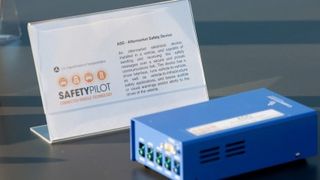The city that's ruled by self driving cars
A place where commuters can read books at the wheel
Safety measures normally use sensors that work in a cocoon. In modern cars like the Infiniti Q56 or 2014 Chevy Impala, a blindspot detector knows if there is a car in the next lane and warns you to stay put. They also display traffic incident reports on the navigation system.
But, these high-tech cars are unaware of actual safety conditions. For example, if there is a crash at an intersection one mile ahead, that data will not appear as a traffic incident in time. (The navigation system intends to warn you about a delay, not as a safety precaution.)

In the Michigan test that concludes next month, the major difference is that other cars send safety messages in real-time. For example, Ford deployed eight Taurus SHO sedans which use seven different applications that read data from the BSM. These include systems that warn you about a forward collision, potential side impact, or a blindspot crash.
To the driver, the messages can take many different forms. The test cars might send the BSM message to the blindspot warning which displays a light near the side mirror. The driver looks to make a lane change, but knows there is an approaching car.
Why is this effective? Shulman says the range is much better in a V2V situation. In a blindspot scenario, you might start moving over in the lane in current production cars, see the warning, but still collide. With V2V, he says, you would get more advanced warning. Another advantage: any new production car could take advantage of the safety warnings without the need for expensive external sensors scattered around the vehicle.

A good example of how this works: the 2013 Audi S7 is already equipped with surround-sound audio warnings. They chime from the direction of an imminent collision. In V2V, you might get a softer chime that grows louder based on a potential hazard. And, the test is even more advanced in terms of potential safety issues between multiple cars.
"Intersection Movement Assist is an application [in the Taurus SHO] which warns when a collision is imminent from the side, such as at an intersection," says Shulman. "For example, imagine if someone violates a red light or a stop sign.
Get daily insight, inspiration and deals in your inbox
Get the hottest deals available in your inbox plus news, reviews, opinion, analysis and more from the TechRadar team.
About 35% of all fatal crashes are at intersections and these crashes are difficult to address with autonomous sensing because of the large field of view required for cameras or radars. Cross Loss Warning is a warning to other vehicles sent when a vehicle has experienced an event such as traction control activation, stability control activation, or airbag deployment."
Test Results
"
About 35% of all fatal crashes are at intersections and these crashes are difficult to address with autonomous sensing because of the large field of view required for cameras or radars
"
As you can guess, the data analytics from a test with nearly 3,000 participants will take time to ingest. (A DOT representative told TechRadar.com it will take several months to analyze the results.) However, Ford's Shulman did say they have some preliminary findings.
"We have seen the expected number of interactions in the field," he says, speaking to TechRadar.com. "The data analysis by the government will be used to estimate the benefits of the system, to potentially justify a regulation mandating this technology.
"The data analysis by the OEMs such as Ford is being used to identify necessary modifications to the standards for the BSM and for improvements to the warning algorithms for the applications."
Shulman says some of the initial test specifications used by all car makers were "ambiguous" and they did not have enough time to identify the issues before the testing started. This points to a need for better standards before there would be a mass roll-out or any US government mandates about what safety features are required in all vehicles on the road.
John Brandon has covered gadgets and cars for the past 12 years having published over 12,000 articles and tested nearly 8,000 products. He's nothing if not prolific. Before starting his writing career, he led an Information Design practice at a large consumer electronics retailer in the US. His hobbies include deep sea exploration, complaining about the weather, and engineering a vast multiverse conspiracy.

Amazon Prime Video's disappearing act could point to a future without the service

Tesla Cybertruck suffers new recall for a very scary problem

'The party is over for developers looking for AI freebies' — Google terminates Gemini API free access within months amidst rumors that it could charge for AI search queries
